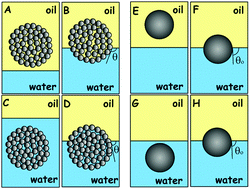Attachment of composite porous supra-particles to air–water and oil–water interfaces: theory and experiment
Abstract
We developed and tested a theoretical model for the attachment of fluid-infused porous supra-particles to a fluid–liquid interface. We considered the wetting behaviour of agglomerated clusters of particles, typical of powdered materials dispersed in a liquid, as well as of the adsorption of liquid-infused colloidosomes at the liquid–fluid interface. The free energy of attachment of a composite spherical porous supra-particle made from much smaller aggregated spherical particles to the oil–water interface was calculated. Two cases were considered: (i) a water-filled porous supra-particle adsorbed at the oil–water interface from the water phase, and, (ii) an oil-filled porous supra-particle adsorbed at the oil–water interface from the oil-phase. We derived equations relating the three-phase contact angle of the smaller “building block” particles and the contact angle of the liquid-infused porous supra-particles. The theory predicts that the porous supra-particle contact angle attached at the liquid interface strongly depends on the type of fluid infused in the particle pores and the fluid phase from which it approaches the liquid interface. We tested the theory by using millimetre-sized porous supra-particles fabricated by evaporation of droplets of polystyrene latex suspension on a pre-heated super-hydrophobic surface, followed by thermal annealing at the glass transition temperature. Such porous particles were initially infused with water or oil and approached to the oil–water interface from the infusing phase. The experiment showed that when attaching at the hexadecane–water interface, the porous supra-particles behaved as hydrophilic when they were pre-filled with water and hydrophobic when they were pre-filled with hexadecane. The results agree with the theoretically predicted contact angles for the porous composite supra-particles based on the values of the contact angles of their building block latex particles measured with the Gel Trapping Technique. The experimental data for the attachment of porous supra particles to the air–water interface from both air and water also agree with the theoretical model. This study gives important insights about how porous particles and particle aggregates attach to the oil–water interface in Pickering emulsions and the air–water surface in particle-stabilised aqueous foams relevant in ore flotation and a range of cosmetic, pharmaceutical, food, home and personal care formulations.


 Please wait while we load your content...
Please wait while we load your content...